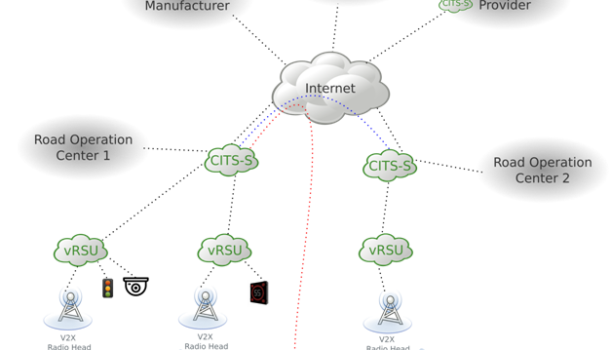We often hear that 5G will revolution the automotive industry. Were the previous generations not powerful enough? What are the new use cases enabled by 5G? Yes, 5G will enable “futuristic” usages notably thanks to increased performance in throughput, latency and quality of service (QoS). For instance, for remote driving, platooning or video intensive use cases. But those are still at the stage of prototype or emerging applications. In this post, we present what is already feasible in production and has been demonstrated in the scope of the 5GASP project funded by the European Commission.
nApp: Applications running at the heart of the 5G network
One important innovation of the 5G technology can not been seen by the end users because it is under the lid. It is related to the core network architecture which is designed as a set of micro-services. Micro- services can host 3rd parties’ applications (aka nApp) at the heart of the network. Either at the edge (for instance in the gNBs), this is the MEC (Multi-access Edge Computing or Mobile Edge Computing) or more centrally in the Cloud. This enables application developers like YoGoKo to host their application as close as possible to the field processing and to directly interact with the 5G Core through the Network Exposure Function (NEF), for instance to retrieve information about the mobile devices (UE), like their position or their connection quality. In the context of 5GASP, YoGoKo provides two nApps.
C-ITS-S: Interconnect with the mobility data providers
The first one is called Central ITS Station (C-ITS-S). It lies in the cloud and makes it possible to aggregate heterogeneous data flows from/to various actors of the mobility sector such as car manufacturers, fleet managers, public transportation administration, public transportation operators, on demand mobility platform, etc. And most importantly: any mobile phone application thanks to the IP connectivity. The C-ITS-S can thus be seen as a data hub and an interoperable gateway to/from the 5G implementing the communication and data management standards for connected and cooperative mobility (aka C-ITS, standing for Cooperartive Intelligent Transport Systems) and letting application developers focus on their core business without bothering with networking and other data transmission issues.

vRSU: The V2X Enabler for Cellular Networks
The second nApp developed by YoGoKo is called Virtual Road Side Unit (vRSU). The RSU are traditionally hardware units installed along the roads to connect infrastructure equipment (traffic lights, cameras, variable message signs, etc) or to broadcast and collect information to/from surrounding road users (traffic, road hasards, speed limitations, counting vehicles, etc). The vRSU ensures the underlying logic, standard message encoding/decoding and cybersecurity features. The software part of the vRSU is hosted in the edge while the physical radio interface is implemented by dedicated radio-heads that can be co-located with eNB/gNB or installed on specific sites of interest. In the latter case, the radio head connection to the core network can be implemented on top of a 5G Uu connection to even simplify the deployment process. Available radio-heads currently support the ITS-G5 and C-V2X short-range 5.9 GHz radio protocols and it will be possible to build NR-V2X in the same way when chipsets are available.

So, the vRSU fulfills the promise of the smooth integration of the V2X protocols and radio access with cellular networks. Such a solution is a must for application developers that can now rely on already deployed and well-known carrier networks without having to deploy any extra infrastructure by themselves.
Everything to Everything made real
Furthermore, when combining the vRSU with the C-ITS-S nApp, it becomes possible to bridge ITS-G5 and C-V2X but also with the Uu connectivity of 3G/4G/5G and even with other data producers or consumers. So, all these heterogenous devices can natively and smoothly discuss together!

We know that this full interoperability between incompatible standards and radio technologies may sound as an unachievable Graal. But this is exactly what these two nApp do! This has the potential to dramatically fasten the deployment of C-ITS services in various domains. Indeed, service providers do not anymore have to be afraid and wait to know which radio standard will win the race. They can just put their solution into production, interconnect with other data producers and reach their end users without worrying about technological issues and evolution. And thanks to the magic of virtualization, the infrastructure scales at the same pace as the market and does not require prior capital expenditure.
So yes! It is possible to have V2X enabled cellular networks. For example, at YoGoKo, we already demonstrate collision avoidance system between cars and pedestrian connected with their smartphones. Of course, other incredible use cases will come in a more or less near future when native 5G deployment releases its full potential. But we can already deploy Day 1 and Day 1.5 services to initiate a fruitful collaboration between the carriers and the service providers.
Stay tune!


